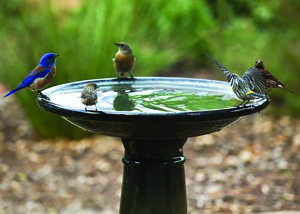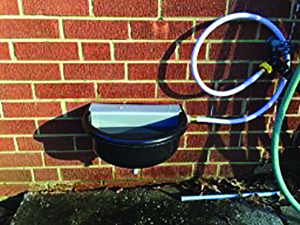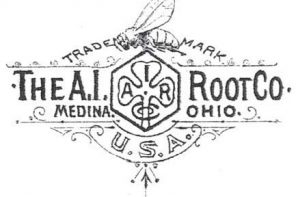By: Ann Harman
“Whew! It’s hot up here on this rooftop. There’s plenty of sidewalk cafes here in the city – let’s go find what they have to offer for thirsty bees!” And so the bees from this rooftop hive head for the nearest café where the sweating drink glasses are sitting in their nice puddles of water. The result: screaming customers swatting at bees (fortunately missing all of them) and an enraged café owner trying to cope with the unfortunate situation.
Bees need water. In hot weather, drops are placed around inside the hive and air is circulated through. The evaporation of water cools the hive to keep an even temperature for brood rearing. Water is also necessary for diluting stored honey so it can be used by foragers for energy and for feeding developing larvae. Many honeys crystallize in the comb. Bees need water to dissolve the crystals to make that honey useable.
City bees will be found in hives in elegant back gardens, tiny back gardens all in a row, balconies and rooftops. The bees will find their floral sources scattered around everywhere but a source of water may be limited, especially outside of residential areas. Although publicity about honey bees and their problems has caught the interest of many people, that does not carry over into appreciating a real bee that is sitting on a café table next to someone terrified of any insect, most especially a stinging one.
 Take a minute and think about possible water sources in cities and towns. Some people may have a bird bath; in some parts of the country small ponds and streams may be part of the landscape. Children may have a small pool to play in during hot weather. Some cities have rivers but these may have public parks on the banks. Dogs who spend much of their day outdoors will be provided with a pan of water. Potted plants outside of a café or a shop will have to be watered. Bees will find any splashed or residual water by those. Parks may have decorative fountains as well as drinking fountains. Puddles from rain are ephemeral but can be used by bees. Some municipalities may have outdoor swimming pools. Pools are also found outdoors at hotels and motels. Bees are definitely not welcome at these. The one bee that finds a water source will, of course, be followed by others from the hive. Soon, especially on a hot day, more bees will be found at the water source.
Take a minute and think about possible water sources in cities and towns. Some people may have a bird bath; in some parts of the country small ponds and streams may be part of the landscape. Children may have a small pool to play in during hot weather. Some cities have rivers but these may have public parks on the banks. Dogs who spend much of their day outdoors will be provided with a pan of water. Potted plants outside of a café or a shop will have to be watered. Bees will find any splashed or residual water by those. Parks may have decorative fountains as well as drinking fountains. Puddles from rain are ephemeral but can be used by bees. Some municipalities may have outdoor swimming pools. Pools are also found outdoors at hotels and motels. Bees are definitely not welcome at these. The one bee that finds a water source will, of course, be followed by others from the hive. Soon, especially on a hot day, more bees will be found at the water source.
Bees are quite small so how much water do they really need? During cool weather a colony might only use up to a quart in a day. But in hot weather, or hot conditions such as rooftops, a single colony can use a gallon in a day. So you need to keep both the number of hives, their placement and the weather conditions in mind when selecting a way to provide a water source.
Not every bird lover will appreciate bees using the bird bath; not every dog wants to cope with bees in the water pan. So what can the urban beekeeper do to avoid the café crisis or the annoyed bird lover with the bird bath. Remember that bees were prohibited from being kept in most urban areas for a long time. Now, with the renewed interest in keeping bees along with the need for pollinator protection, those prohibiting regulations have been removed. However, if problems persist, regulations can be revived.
A number of things need to be considered in providing water for urban bees. One is climate. In the far south, especially in desert areas, a water source for bees will need to be provided the entire year. In climates with cold Winters with bees confined to their hives, their water source is needed only during months they are flying. Bees quickly learn their water source and will continue to use it as long as it is available. Therefore in cold climates water should be made available as soon as flying weather is possible. True, the water may freeze at night or even during cold days, but it is essential to train the bees as early as possible.
If you are just setting up an apiary, even if it’s just one hive, in an urban setting, set up the water source at the same time. Scent the water initially with a food flavoring or Honey Bee Healthy. Then your bees will not go on a search for a source elsewhere. It will be essential to monitor your water source in urban areas. If the water disappears for any reason the bees will promptly fly out to discover a new source. They may or may not return to your original source after it has been refilled.
Once you have chosen a way to provide water, monitor it over a week. If your water system seems overcrowded with bees perhaps you need something larger or may need two or more water stations. Consider how many hives you have as well as consider if some of those bees are from elsewhere and are in need of water. If bees need water, go ahead and give it to them!
Do bees prefer “flavored” water or just plain tap water? Minerals are scarce in nature and tap water, probably the only source in urban areas, may well be lacking in both taste and odor. Swimming pools have an odor and taste from the chemicals added to make them safe for humans to use. So swimming pools provide “flavored” water with an attractive odor. In rural areas honey bees are found visiting puddles or water troughs in barn lots where livestock spend some time. Odor and minerals are always available there.

For urban areas the gravity-fed waterers can be a good choice. The Boardman feeder, sold by bee equipment suppliers, is one type. It can be used as an “entrance waterer.” However only a one- or a two-quart jar will work best at the hive entrance. During hot weather two quarts may not be enough even for one day.
Searching for different waterers can be done very well on the Internet – search automatic chicken waterers. True, many will be unsuitable for bees, especially the nipple type or the ones where the chicken must peck at a float. But you will find commercial gravity-fed ones that hold two gallons or more. In addition you can find plans to make your own from three- or five-gallon plastic buckets and even a large one made from a galvanized rubbish bin.
Bees like something to hold onto. Their feet end in a set of claws so they can easily grab onto something rough while obtaining water. Since the surface of the bottom dish of gravity-fed waterers is smooth and slippery plastic, adding a few floating twigs to the drinking area would be a good idea.
If you choose to use an open pan, adding twigs or floats of pieces of rough wood will greatly help the bees. Some books will suggest forming a bottom layer of small stones for the bees. However this arrangement can make it difficult to have enough water available in very hot weather and also make it difficult to clean if debris gets blown in.
In gardens with faucets for garden hoses beekeeping books will suggest leaving it drip onto some bricks or stones for the bees’ water source. However, many municipalities caution against dripping faucets, whether inside homes or outdoors, as being wasteful of the town’s water supply. Since people living in places with water service are being charged for water usage, and frequently an additional sewer charge, a dripping outdoor faucet could increase the monthly water bill. The drips may not look like much but over many hours those drips would add up. True, you could have a timer on the faucet but it would have to turn the faucet on at daylight and off at dark every day. If you had to do that, yes, you would forget. Then your bees might visit that neighbor’s bird bath or children’s pool.
In gardens, bird baths make an attractive bee waterer. Birds and bees will share the water source. Or you can put a bird bath in the apiary and another one near your bird feeders. Some bird baths are available with automatic refilling devices. These would be very handy since the amount of water in most bird baths is not very much. Another solution could be an automatic-refill large-dog waterer. The Internet is filled with ideas for both bird baths and for large-dog waterers. You want to search for “large dog” because those would have the quantity of water you need for bees. No matter which of these two you choose, the bees will appreciate some twigs or small pieces of rough wood to stand on.

Ann Harman has been showing us how to keep our bees healthy for a lot of years from her home in Flint Hill, Virginia
Attractants can be added to the water supply. Products for bees that have lemon grass in them could be added in very small amounts. You might not be able to detect the odor, but the bees would. Farmers with livestock of all kinds have been using 50-pound Redmond Salt blocks for their animals. It is a pink-red salt mined in Utah that naturally has both ordinary salt plus naturally-occurring minerals. If mounted outdoors, rain will wash a bit down on the ground. When the ground is a little damp you will find bees, butterflies, other insects, squirrels and other critters eagerly licking the block or the ground under it. Minerals are scarce in Nature! You can obtain small amounts of Redmond Salt (called “Real Salt” in a 10-ounce shaker or a 16-ounce pouch) and add a pinch or two to your bees’ water supply. They will appreciate it.
If your beeyard is a rooftop it can be a hot climate even in a cold climate area. Some rooftops now have been made “green” with many kinds of plants. These may actually have a source of water that you can use to refill your bee waterer. Other rooftops are just that – a flat roof covered with some sort of roofing material. Such roofs may get very hot. The bees can cope but your waterer might benefit from some sort of shade over it to prevent it from baking in the sun. Be certain that any type of shade will not blow off in high winds.
Have you thought about someone to take care of your water source when you go for an out-of-town vacation? The bees themselves in their hives may not need any attention but their water source cannot go dry. If you belong to a local bee club perhaps the members can assist each other for vacations. Even if you choose a watering source with automatic refill, have someone check from time to time, especially in areas of severe thunderstorms or high winds.
Consider your bees’ water as important as sufficient food. Actually more so in urban areas where more honey bees are living now.









